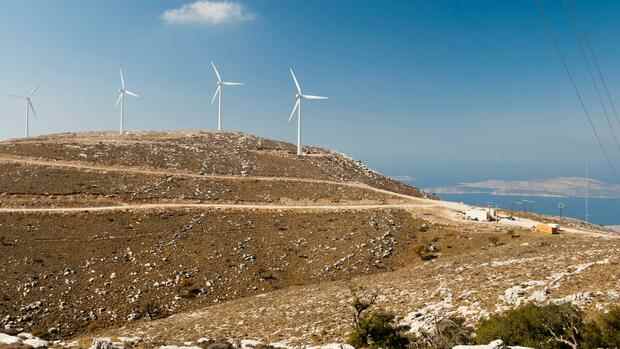Athens Not only sailors appreciate the strong winds around the islands of the Aegean Sea. Now energy companies are also focusing on Greek waters. The government in Athens intends to award the first concessions for offshore wind farms to private investors in the next few years. Prime Minister Kyriakos Mitsotakis has now announced that plants with a capacity of two gigawatts (GW) will be connected to the grid by 2030.
But this is only the beginning. The country’s offshore wind power potential is huge: the Greek Ministry of Energy estimates it to be around 40 GW. That would be almost double the total installed power plant capacity in the country and ten times the wind turbines installed on land today.
However, it is unlikely that these reserves will ever be fully utilized. Because there are technical limits. Because of the great depths of the water, mostly floating wind turbines (FOW) have to be used in the Aegean.
The technology is only at the beginning of its development. These systems enable electricity to be generated in sea areas with higher and more uniform wind speeds. However, because of the anchoring and cabling, the construction of floating platforms is technically challenging and more expensive than the installation of conventional wind turbines that are fixed on the seabed.
Top jobs of the day
Find the best jobs now and
be notified by email.
There are also political obstacles: The decades-old dispute with neighboring Turkey over sovereign powers and economic zones in the Aegean Sea is severely restricting Greece when planning offshore wind farms. The government can currently only grant concessions for wind farms within the Greek territorial waters, which are limited to six nautical miles (11.1 kilometers).
Climate goals cannot be achieved without wind power
One thing is certain: Greece cannot achieve its ambitious climate targets without wind power. By 2030, 67 percent of the electricity consumed should come from renewable sources. The share is currently 30 percent.
Greece cannot achieve its ambitious climate targets without wind power.
(Photo: Reuters)
So far there are wind turbines with a total capacity of 4.1 GW. They are all on land and cover up to twelve percent of the electricity demand. In order to achieve the climate neutrality agreed by the EU by 2050, the government is relying on the massive expansion of offshore wind farms.
There is great interest from investors. At the beginning of December, a delegation from the Norwegian Offshore Wind Cluster (NOWC) came to Athens. The visitors met with Prime Minister Mitsotakis’ chief economic advisor, Alex Patelis, and representatives of Greek companies.
The NOWC includes around 330 companies in the offshore wind industry, including the energy company Equinor, which commissioned “Peterhead Hywind Scotland”, the world’s first floating wind farm, off the Scottish port in 2017.
Offshore wind energy will play a key role in the implementation of the EU climate targets in Greece, according to a study by the Athens think tank Eliamep. According to a model calculation, an offshore plant with an installed capacity of 495 megawatts (MW), which is anchored ten kilometers off the coast in a water depth of 250 meters, would require investments of one billion euros over the entire lifespan of 25 years.
With an annual output of two million megawatt hours (MWh), such a wind farm could cover around four percent of today’s electricity consumption in the country and save 1.5 million tons of CO2. The Eliamep researchers put the social benefit at 1.7 billion euros.
In a few weeks, the Greek Ministry of Energy intends to present a draft law with the regulatory framework for offshore wind farms. The first concessions are to be awarded in 2023.
Particularly suitable locations are the sea areas around the Cyclades Islands, the northern Aegean, the region of the Dodecanese archipelago in the southeastern Aegean and the sea between the islands of Crete and Karpathos.
Network expansion necessary
An important step in utilizing the offshore wind potential is the expansion of the grid. Around 60 of the 110 permanently inhabited Greek islands are still not connected to the mainland electricity network.
They get their electricity from diesel power plants. By 2030, all inhabited islands are to be networked with one another and connected to the mainland. The network operator Ipto is investing 4.3 billion euros in this.
Some of the Greek islands are not connected to the mainland electricity network.
(Photo: imago images / ANE Edition)
With this, Greece does not only want to reduce the CO2 emissions of the oil-fired island power plants. Networking is also a prerequisite for feeding the electricity from the planned offshore wind farms into the national grid.
But foreign policy entanglements threaten. The plans to use wind energy give the old Greek-Turkish dispute over territorial waters and economic zones in the Aegean a new dimension.
The core of the problem is that Turkey does not recognize the United Nations Convention on the Law of the Sea (UNCLOS). As a candidate for EU membership, it would be obliged to do so. Because the UN maritime law is part of the “acquis communautaire”, the legal acquis of the EU.
The agreement, which came into force in 1994, defines the extension of the territorial waters to twelve nautical miles (22.2 kilometers) and defines the rules for the demarcation of the Exclusive Economic Zone (EEZ).
Greece currently claims a sovereign zone of six nautical miles in the Aegean Sea, but reserves the right to expand it to twelve nautical miles based on UN maritime law. According to its Foreign Minister Mevlüt Cavusoglu, Turkey would regard this as a “casus belli” – a reason for war.
More: A small Greek island wants to become climate neutral – and hopes for digital nomads
